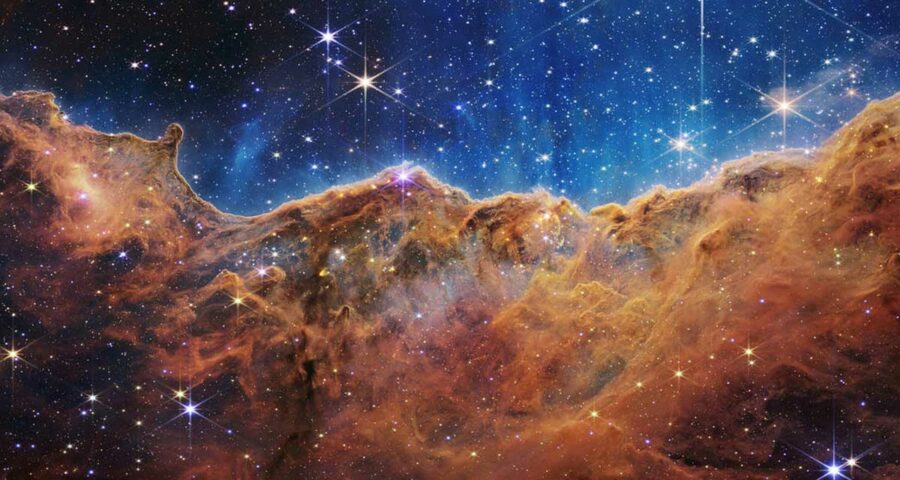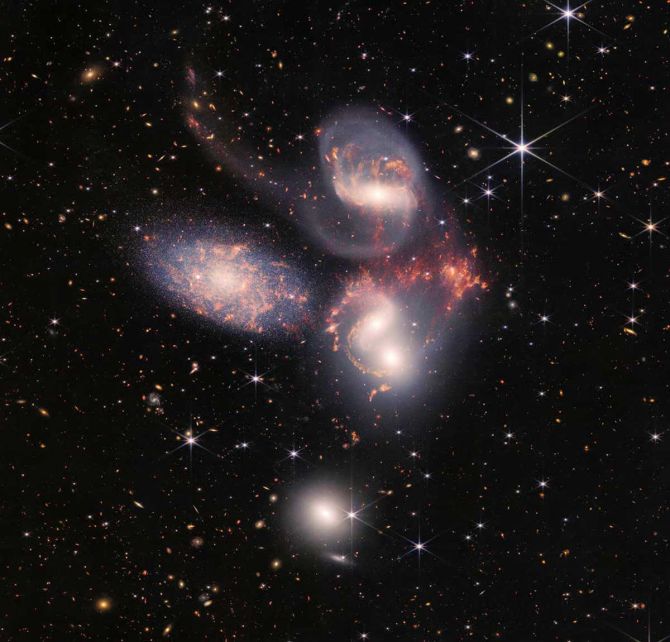NASA has revealed five never seen before images of the universe captured by the James Webb Space Telescope, July 12, 2022.
Star Birth
In the image, the landscape of ‘mountains’ and ‘valleys’ speckled with glittering stars is actually the edge of a nearby, young, star-forming region called NGC 3324 in the Carina Nebula.
This infrared image reveals previously invisible areas of star birth.
It is the edge of the giant, gaseous cavity within NGC 3324, and the tallest ‘peaks’ in this image are about 7 light-years high.
The cavernous area has been carved from the nebula by intense ultraviolet radiation and stellar winds from extremely massive, hot, young stars located in the center of the bubble, above the area shown in this image.
Galaxy
Stephan’s Quintet, a visual grouping of five galaxies, is best known for being prominently featured in the holiday classic film, It’s a Wonderful Life.
This enormous mosaic is the Webb Space Telescope’s largest image to date, covering about one-fifth of the Moon’s diameter.
It contains over 150 million pixels and is constructed from almost 1,000 separate image files.
The information from Webb provides new insights into how galactic interactions may have driven galaxy evolution in the early universe.
Sparkling clusters of millions of young stars and starburst regions of fresh star birth grace the image.
Sweeping tails of gas, dust and stars are being pulled from several of the galaxies due to gravitational interactions.
Webb captures huge shock waves as one of the galaxies, NGC 7318B, smashes through the cluster.
Star death
The dimmer star at the centre of this scene has been sending out rings of gas and dust for thousands of years in all directions. The Webb Space Telescope revels that this star is cloaked in dust.
Two cameras aboard Webb captured the latest image of this planetary nebula, cataloged as NGC 3132, and known informally as the Southern Ring Nebula. It is approximately 2,500 light years away from earth.
Exoplanet
The Webb Space Telescope has captured the distinct signature of water, along with evidence for clouds and haze, in the atmosphere surrounding a hot, puffy gas giant planet orbiting a distant Sun-like star.
The observation, which reveals the presence of specific gas molecules based on tiny decreases in the brightness of precise colours of light, is the most detailed of its kind to date, demonstrating Webb’s unprecedented ability to analyse atmospheres hundreds of light years away.
Deep Field
The Webb Space Telescope has produced the deepest and sharpest infrared image of the distant universe to date.
Known as Webb’s First Deep Field, this image of galaxy cluster SMACS 0723.
Thousands of galaxies — including the faintest objects ever observed in the infrared — have appeared in Webb’s view for the first time.
This slice of the vast universe covers a patch of sky approximately the size of a grain of sand held at arm’s length by someone on the ground.
Feature Presentation: Ashish Narsale/Rediff.com
Source: Read Full Article






